Driving digital transformation one touch at a time
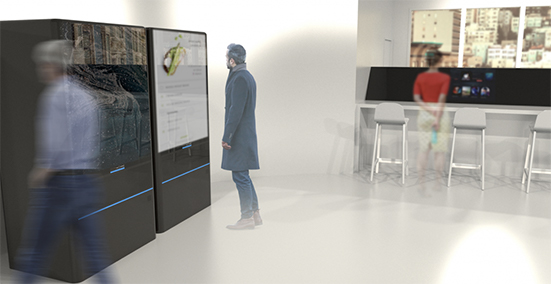
Driving digital transformation one touch at a time 3M Share Experientia gathered expert insights and voice of customer insights about intelligent self-service applications to create coherent storytelling for 3M clients and to provide compelling choices through predictive, engaging and learning touchpoints. We conducted a global benchmark research and interviews with industry experts to understand trends, changing paradigms and crucial concepts around intelligent self-service and created a B2B sales tool prototype: the innovation playbook that communicates the research outcomes. 3 things to know Global research Our benchmark focused extensively on Europe, US, China and Japan while industry experts joined our research from 5 different countries, bringing insights from all around the world. Driving digital transformation Design principles modelled empathic, people-centric frameworks for developing self-service experiences. Innovation playbook in action Future scenarios illustrate fast, intuitive, hassle-free experiences to end users who expect beauty and usability, familiarity and seamless connections. Gallery In depth Service mix: Design thinking Envisioning Business strategy design Information architecture Participatory design Service design Ethnography Context 3M offers a wide range of standard and customizable single-touch and multi-touch systems that are easy to integrate into OEM and display solutions, as well as a portfolio of fully integrated displays. This allows 3M clients to create interactive and immersive touchscreen experiences with systems and displays that are engineered for commercial applications and backed by advanced touch technology that’s ultra-fast, reliable and responsive. Challenge 3M reached out to Experientia to better understand its customers context and future scenarios that could strengthen its service offering. Research Experientia conducted a global benchmark research, collecting best practices and global innovative examples of self-service UX/UI systems, extracting relevant themes and trends. We interviewed 10 experts in architecture, design, food & beverage to gather first hand knowledge on how customer experiences are fueling innovation in the segment, and to understand trends, changing paradigms and crucial concepts around intelligent self-service. Design Experientia prioritized the interview insights using affinity mapping and constructed near-future scenarios analyzing different factors affecting UX. Ideation sessions generated new ideas to redefine how brands engage customers with intelligent self-service applications. Experientia designed a self service innovation playbook documenting research insights, design principles and scenario. It comes in a box containing the insights booklet, idea cards and impact map for co-creation, to aid collaborative design making. Impact The self service innovation playbook is now being used as a B2B sales tool to engage clients. Related projects All Services Behavioral design Research and assessment Strategy B2B Collaboration UI, redesigning the filter navigation experience B2B Reinventing customer and supplier interactions for a multinational flooring company B2B AR tools for industrial maintenance Go back to our portfolio
Packaging upgrade for Chinese food producer
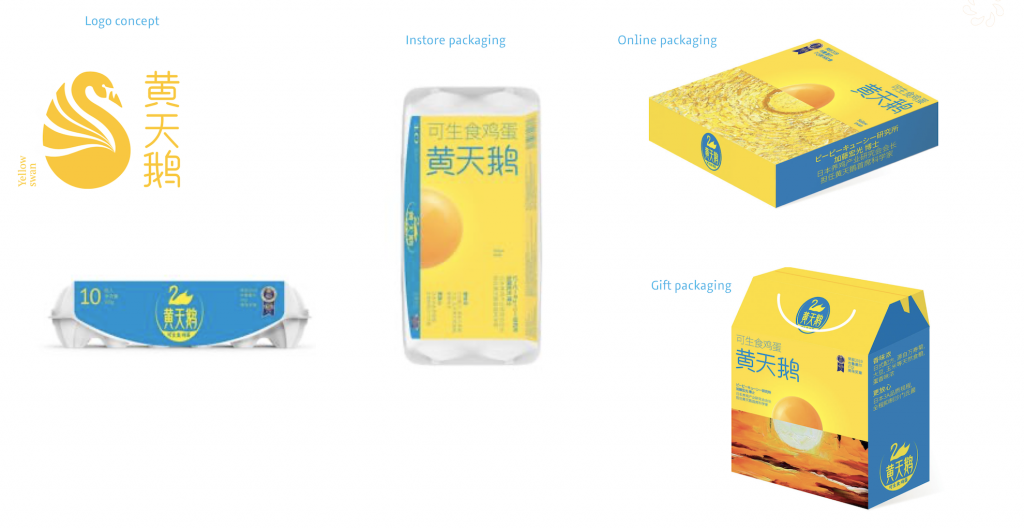
Packaging upgrade for Chinese food producer The Yellow Swan Share The Yellow Swan is a new Chinese food company committed to the highest quality standards of egg production. Building on the Japanese practice of eating raw eggs in the morning, Yellow Swan produces high quality eggs to be eaten raw. The company aims to build world-class high-quality egg leadership brand based on innovative technology, equipment, and production management models. 3 things to know Packaging design explores the core value of the brand The core value of the brand is quickly and immediately communicated to consumers through the packaging. Pictographic graphics logo design builds new brand identity We simplify the shape of swan and yolk to make it more friendly and geometric. Creative and easy to identify. Different sales platform use different packaging design We designed different packaging for different sales platforms to maintain the unity of the visual system. Gallery Egg box design Identity “Simply natural” concept “Safe and good to eat raw” concept “Swans in Chinese scenery” concept “Eat it raw” concept “Sunrise” concept In depth Service mix: Design thinking Business strategy design Description The project involved a concept development phase to solve specific packaging design needs of the brand. We developed 2 main packaging design concepts from supportive visuals and content to a precise brand message. The aim was to develop a concept that provides a distinct design solution and effortless effectiveness on multiple levels, is unique, and stands out from retail shelfs. Experientia redefined the overall brand visual identity and strategy in terms of brand’s core values, brand voice, and brand messaging architecture, and then developed the production ready design specifications of the instore, online and gift packaging. Related projects All Services Behavioral design Research and assessment Strategy Brand UX Qualitative research on food and drink consumption to develop new consumer services Brand UX Redesigning the visitors’ museum experience Go back to our portfolio
Finding entertainment on the go

Finding entertainment on the go Netflix Share Inspiring the future of mobile entertainment: a global desk research to identify emerging trends, innovations, and best practices in onboarding, sign-up and consumption in the coming 5 years. 3 things to know Global reach with local sensitivity Local researchers from the regions of SE Asia, Asia and Latin America contributed to uncover findings with high relevance for each of their own markets. A user-driven, visionary focus Visionary trends were user-driven, meaning that we put users at the center to define what changes in mobile entertainment would potentially have a greater societal and behavioral impact. Triggers for innovation From the understanding of the cultural, social dimensions and technologies we gave interaction design directions on how those trends could be meaningfully applied. Gallery In depth Service mix: Design thinking Challenge Experientia was asked to explore current, innovative and inspirational best practices in entertainment onboarding and sign-up processes from a global point of view, with an emphasis on Asia and Latin America. Research We carried out a research to identify the best practices relevant for mobile entertainment. We gathered over 200 examples of inspiring technology in collaboration with a team of local researchers from India, the Philippines, Indonesia, South Korea and Latin America. Following the research, we developed a trend analysis, looking at consumer behaviors, cultural clues and technology developments with a possible impact in mobile entertainment in the year 2022. Impact We imagined how those trends may have an impact on Netflix. After an in-house ideation session, we selected 39 inspirational ideas to sparkle the creativity of the design team at Netflix. The short ideas looked at design solutions for the onboarding, use and consumption of mobile entertainment Related projects All Services Behavioral design Research and assessment Strategy Consumer technology Buttonless: engaging users in interactions with keyless devices Consumer technologyFinance BancoSmart, an award-winning ATM Consumer technology Exploring urban dwelling usage to inform appliance design Go back to our portfolio
Reinventing customer and supplier interactions for a multinational flooring company
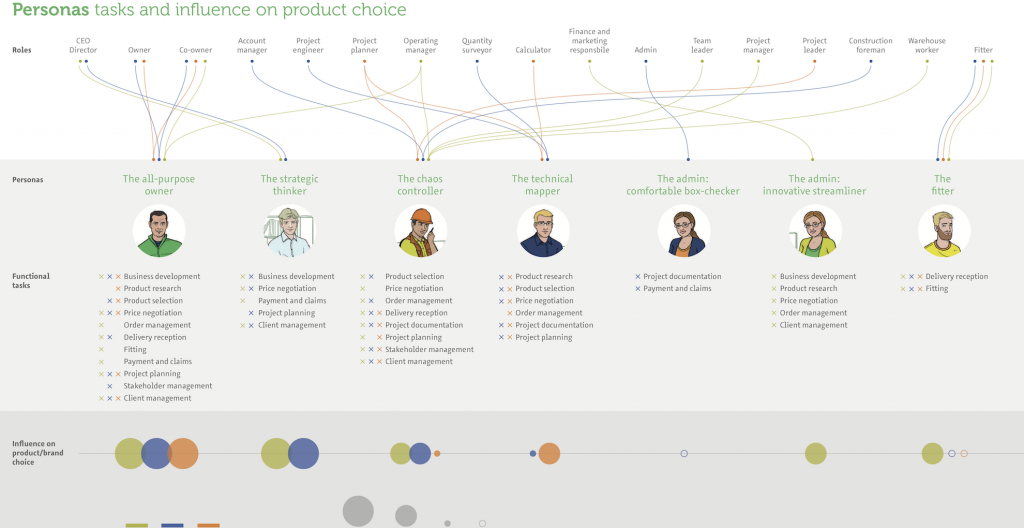
Reinventing customer and supplier interactions for a multinational flooring company Tarkett Share Tarkett, a multinational flooring manufacturer, asked Experientia to explore ways to make them the easiest flooring company to interact with in Europe and the Americas. Experientia conducted in-depth ethnographic research, including contextual interviews and shadowing, in five different countries across Europe, the USA and Russia. We investigated the diverse range of stakeholders of the company, from architects, to flooring installers, wholesalers and retailers. 3 things to know Global research Our benchmark focused extensively on Europe, US, China and Japan while industry experts joined our research from 5 different countries, bringing insights from all around the world. Our local researchers conducted contextual interviews with architects, installers and retailers across five countries, ranging from observations of fitters removing flooring at Paris’ Roissy airport to discussions about design choices with architects in New York. Driving digital transformation Design principles modelled empathic, people-centric frameworks for developing self-service experiences. Innovation playbook in action Experientia designed innovative client-centered product/service solutions to improve supply chain performance, internal processes and company culture and grow Tarkett customer experiences. Gallery In depth Service mix: Design thinking Business strategy design Participatory design Behavioral modeling Ethnography Context A historic manufacturer of flooring products of all types, Tarkett faced the challenge of having to address increasingly fast supply lines at construction sites, while the move to digital experiences meant that they had to rethink and restructure their entire service experience. Challenge Our role as Tarkett’s user experience partner was to consolidate key knowledge dispersed across regional and functional divisions, act as an objective research partner in communicating their customers’ varied service and product needs and propose relevant, innovative solutions to improve the customer experience. Research Experientia interviewed and observed 80+ architects, flooring installers, wholesalers and retailers In USA, France, Netherlands, Sweden and Russia, using a range of ethnographic research methods including expert interviews, contextual inquiries and co-creation workshops. Stakeholders interviews and co-creation exercises with a variety of professional roles mapped the supply chain experience of commercial flooring products and services. Fieldwork results, customer journey maps and personas identified emerging themes ranging from sales relationships to life cycle approaches, product sampling to information management, deliveries to work flow issues. This initiative combined Tarkett’s EMEA, Russia and North America teams to share knowledge and work together on developing promising service concepts. To ensure that expert knowledge was incorporated into foundational research, we conducted stakeholder interviews with a range of employees from country sales managers to C-suite executives, who we involved throughout the research design and ideation processes. Design Experientia generated 150+ service opportunities for the different market segments. Co-design sessions with architects, interior designers, installers and retailers evaluated, prioritised and iterated select service opportunities. High value concepts were developed into concept prototypes and tested in the markets. Impact Our painpoint analysis was taken forward by the company into a detailed action plan: the simplest were addressed immediately, while other were the focus of more structured, longer term interventions. New initiatives and projects were launched, including a service for architects who could send their CAD drawings and renderings to Tarkett with 3 floor choices and would receive a few days later – and free of charge – a completed rendered visualization with those floors. Related projects All Services Behavioral design Research and assessment Strategy B2B Collaboration UI, redesigning the filter navigation experience B2B AR tools for industrial maintenance B2B Driving digital transformation one touch at a time Go back to our portfolio
Qualitative research on food and drink consumption to develop new consumer services
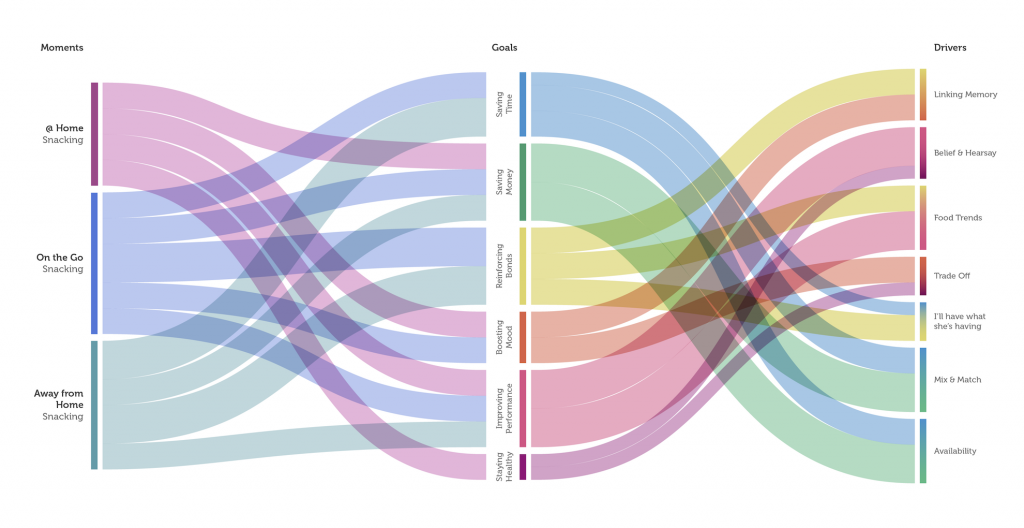
Qualitative research on food and drink consumption to develop new consumer services The Coca-Cola Company Share The Coca-Cola Company has very detailed marketing research, and decided to add to explore the role of ethnography as an additional method to help them identify and map external and internal triggers for beverage consumption. 3 things to know Ethnography as new method An additional method for the Coca-Cola Company to gain insight and explore opportunities. Instagram Participants are asked to take a pictures and describe what they are snacking during the day by receiving a message right before the foreseen snacking time. Insight visualization Strong emphasis on visualization to translate results into actionable opportunities. Gallery In depth Service mix: Design thinking Behavioral modeling Ethnography Context Consumption of food and drink can be tangential and fragmented in our rushed urban lives. The Coca-Cola Company wanted to understand better how to understand people’s behaviors and explore opportunities for new products or services. Challenge The Coca-Cola Company asked Experientia to support them in an ethnographic research project on snack time, that should also act as a learning opportunity for the company. Research Experientia conducted a qualitative research targeting young consumers to help the Coca-Cola Company identify triggers, behaviors and expected rewards in beverage consumption during snack time. The approach involved 9 contextual interviews, 10 hours of fieldwork observations and 4 digital diaries on Instagram accounts. Activities tools such as the routine map, the beverage cards and the packaging cards supported the researchers to collect data from participants’ stories. The insights have been later visualized in order to identify new opportunity areas for the Coca-Cola Company. Design Although mostly a research project, we explored design visualizations to help the company representatives better make sense of the results. Impact The results were presented during an internal workshop in Milan with marketing managers from across Europe, who then iterated on the topics identified, and matched them with their own data. Related projects All Services Behavioral design Research and assessment Strategy Consumer technology Buttonless: engaging users in interactions with keyless devices Consumer technologyFinance BancoSmart, an award-winning ATM Consumer technology Exploring urban dwelling usage to inform appliance design Go back to our portfolio
Mapping the SPID registration journey, to improve the citizen experience
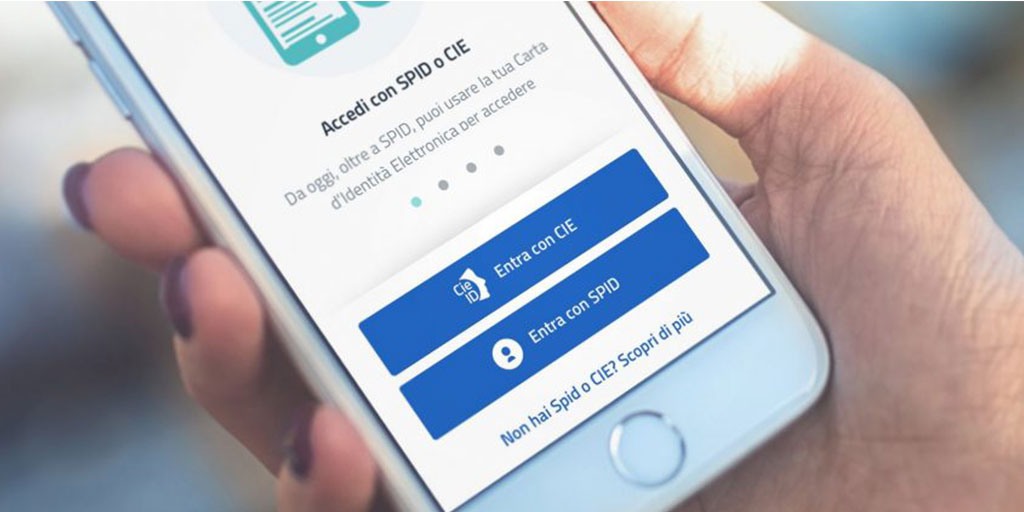
Mapping the SPID registration journey, to improve the citizen experience Department for digital transformation, Presidency of the Council of Ministers Share Driven by the necessity to improve and expand the national system of digital Identity called SPID, the Department for digital transformation, Presidency of the Council of Ministers selected Experientia to conduct a heuristic evaluation to assess the various end-to-end digital registration flows and qualitative research with Italian customers who had registered in the previous 6 months. The objective was to understand the critical needs and pain points in the overall service experience in order to provide UX guidelines and an updated strategic roadmap for improving current processes. 3 things to know A single “key” to access the public administration The government ambition was to provide citizens with a single access method to all the services offered by a multitude of organisations in the public administration. SPID applications grew more than twofold during the first COVID-19 lockdown. A multitude of registration options Our heuristic evaluation assessed 3 different registration processes for the 9 official SPID providers on both desktop and mobile. Some providers offered up to 6 different sign-up flows. People just wanted to avoid queueing The COVID-19 pandemics and the social distancing rules encouraged SPID citizens to sign-up using remote options even for ID validation. One of the strongest motivation to avoid analog ID validation was to avoid queuing in public offices. Gallery In depth Service mix: Design thinking Participatory design Service design Context Driven by the necessity to improve and expand the national system of digital Identity called SPID, the Department for digital transformation, Presidency of the Council of Ministers selected Experientia to conduct a heuristic evaluation to assess the various end-to-end digital registration flows and qualitative research with Italian customers who had registered in the previous 6 months. The objective was to understand the critical needs and pain points in the overall service experience in order to provide UX guidelines and an updated strategic roadmap for improving current processes. Challenge The objective of the project was to understand the critical needs and pain points in the overall service experience in order to provide UX guidelines and an updated strategic roadmap for improving current processes. Research The project started with stakeholder interviews to clearly outline the strategic objectives of the project and of the wider SPID system. We conducted an heuristic evaluation about the UX of requesting SPID to identify major issues in the mobile and computer-based subscription experience. Followed by in-depth interviews with 18 Italian citizens to better understand their overall experience in the subscription and use of the SPID system. Design The analysis of combined research outcomes enabled us to identify crucial issues and opportunities for subscription and service improvement. The recurring patterns of customer expectations and behaviours allowed to build 4 customers journeys based on 4 customers profiles. During a participatory workshop with relevant internal stakeholders, we validated and prioritized opportunities to improve the current UX registration experience and systemic opportunities to support the growth and flexibility of the SPID system for the years to come. Related projects All Services Behavioral design Research and assessment Strategy Cities & InfrastructureSocial innovation ToNite: social innovation and urban regeneration in Turin, Italy Social innovation Turin Public Libraries, redesigning the cultural experience Social innovation COE, Strengthening access to justice through non-judicial redress mechanisms Go back to our portfolio
Singapore: a city for people aging gracefully
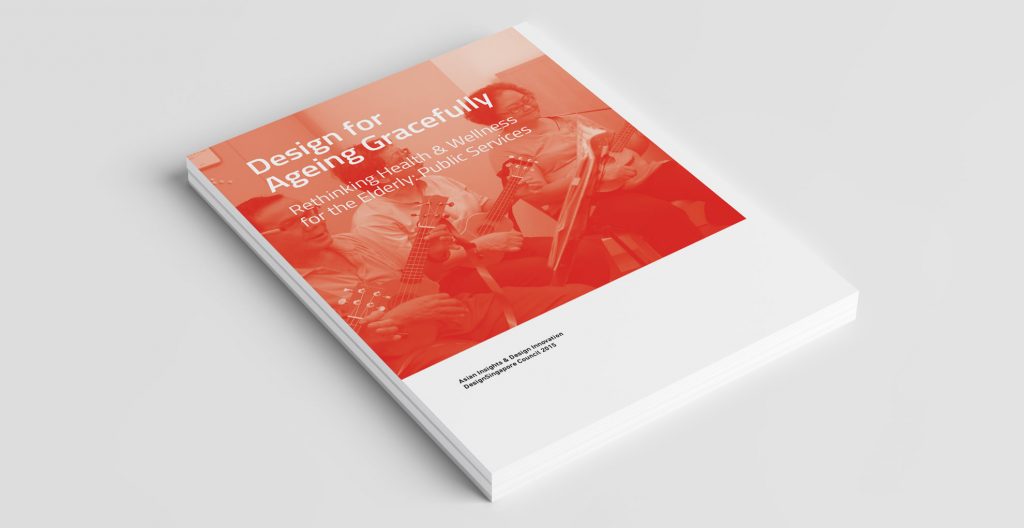
Singapore: a city for people aging gracefully DesignSingapore Council Share DesignSingapore Council asked Experientia to explore health and wellness for the elderly in the Singaporean public sector. We conducted ethnographic research and participatory design workshops, as part of a drive to develop design-led innovation for the health industry. 3 things to know Design ethnography and service design Experientia explored current healthcare experiences of the aging population in Singapore through design ethnography identify opportunities for design-driven innovation in public healthcare. We identified opportunity areas for design-driven innovation in the Singaporean public healthcare space to help Singapore create the right conditions to support a rapidly aging society. Interactive map of findings The interactive map allows people to browse the personas alongside field research videos, that communicate the research findings in the participants’ own words. Long lasting impact The findings have been incorporated in the Health Ministry’s ongoing Action Plan For Successful Ageing, and guided the development of a new residential impact. Gallery Singapore is proactively addressing the problems of a rapidly aging society We explored what is like to grow older in Singapore today, carrying out contextual interviews and shadowing with elderly people, their carers, and people with the healthcare industry. In participatory design workshops with Singaporean stakeholders, we introduced experience design guidelines and created concepts and strategies to improve the elderly healthcare system in Singapore. Our 8 personas show different experiences of aging and using the healthcare system in Singapore. Our customer journeys maps show the typical issues the participants experiences as they tried to manage their health. In depth Service mix: Design thinking Policy development Envisioning Participatory design Service design Behavioral modeling Ethnography Useful links: Download the pdf English language Website External link Singapore press External link Press release External link Press article External link Press article External link Context By 2030, Singapore will experience a profound shift in its age demographics with the elderly population increasing by three times. This calls for a radical change in perspective on how care can be better delivered to the elderly. Challenge To prepare and plan for that change, The DesignSingapore Council’s Asian Insights and Design Innovation (AIDI) programme embarked on a Rethinking Health and Wellness for the Elderly project to look into developing design solutions that better meet the needs of the elderly in Singapore, and asked Experientia to carry out an extensive research and analysis project , including a workshop with participating public agencies and services from the Singapore healthcare system. Research The project started with an understanding of global trends in elderly healthcare services. This was then followed by a design ethnography study through interviews and shadowing – to gather deep qualitative insights into the habits and behaviours of the elderly and to identify trends, behaviors and gaps in the interaction between elderly people and the healthcare system. From the observations, we learned about how the elderly think, act and feel towards managing their health at home and their needs and wants. Experientia developed 8 personas to begin the process of designing for behavioural change and explore solutions like ageing-in-place, peer-to-peer support and community platforms to solve some of the elderly healthcare issues. Participatory workshops allowed stakeholders from the public to be part of this process generating 12 main user-centred design concepts. In two multi-day innovation workshops with healthcare and public service stakeholders, representatives from the healthcare industry and public sector joined Experientia and DesignSingapore Council in Singapore. Here we introduced the challenges the participants face on a daily basis, showing video clips from the research to reveal the human faces behind the research. The stakeholders developed service concepts that would suit the unique characteristics of Singapore. Design Experientia team designed an interactive map of findings, a rich database resource that invites stakeholders to explore and be inspired to innovate and design relevant solutions for the ageing population. The concepts were useful to guide Singaporean healthcare agencies to create strategies, policies and services. The results of the project were compiled in a handy publication for further use in Singapore and freely available for anyone. As part of the project, Experientia also worked with Singaporean agencies and ministries to devise community-focused concepts for elderly residents in the Kampung Admiralty residential block. Co-creation workshops prototyped key policy decisions on ageing, health and housing. Impact Experientia’s report recommendations were widely reported in the Singapore press and were integrated in the Government’s $3billion Action Plan for Successful Ageing (website – pdf – press release – press article). The Kampung Admiralty residential block has been completed. It incorporated many of the concept ideas that were co-created in the Experientia-lead workshops. Download the pdf English language Website External link Singapore press External link Press release External link Press article External link Press article External link Related projects All Services Behavioral design Research and assessment Strategy Cities & InfrastructureSocial innovation ToNite: social innovation and urban regeneration in Turin, Italy Health GoCare: Interactive dashboard for a better home hospitalization service Health Rare disease patient journey mapping Go back to our portfolio
CSA: sentiment-based decision support platform for crypto-currency trading
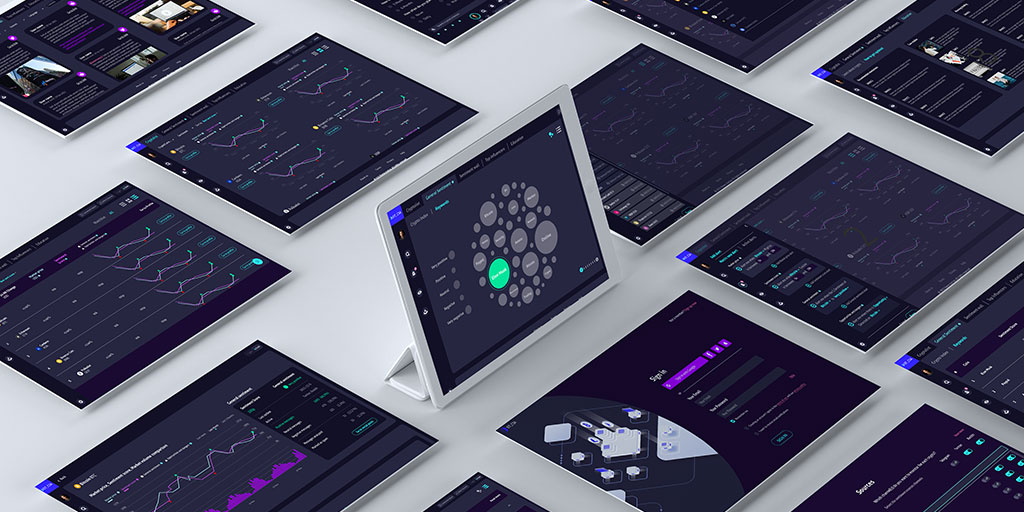
CSA, Sentiment-based decision support Platform for crypto-currency trading EIT Digital, European Research Project Share As a partner of the CSA-Crypto Sentiment Advisor (an EIT research project), Experientia co-designed a web-based dashboard to inform better decisions in the crypto market. Leveraging traders’ individual level of expertise, the solution aims to mitigate risk by using real-time community sentiment data. 3 things to know Understand the habits of cryptotraders By interviewing cryptotrading experts and cryptotraders with different levels of experience, we were able to understand their habits, their sources of information, and the web platforms currently most used by those who invest in cryptocurrencies. Define the value proposition Using co-design methodology we worked with other project partners to identify a USP and the platform’s MVP: a dashboard to inform better decisions in the crypto market by using real-time community sentiment data. Design and validate the MVP solution Based on the results of the research and the co-design work done with the project partners, we designed the UX/UI of the platform, validated it with user interviews, and defined web development specifications. Gallery In depth Service mix: Design thinking Prototyping Information architecture Participatory design Ethnography Context As a partner of the CSA-Crypto Sentiment Advisor (an EIT research project), Experientia co-designed a web-based dashboard to inform better decisions in the crypto market. Leveraging traders’ individual level of expertise, the solution aims to mitigate risk by using real-time community sentiment data. Challenge The platform is based on a sentiment analysis model for cryptocurrency using advanced machine learning methods. Investors can use the signals to manage volatile phases of their portfolio to be well positioned in difficult times. During the research phase, Experientia conducted research interviews with lead users and led co-design activities with project partners to identify the Value proposition and the MVP functionalities. In the design phase, we designed the dashboard prototype and validated it with potential users. Research During the “early bird period” November-December 2020 Experientia research team conducted remote stakeholder interviews. The in-depth interviews allowed us to investigate the research question from a broad, comprehensive perspective. The main objective of the research was to investigate and identify opportunities for helping cryptotraders with sentiment-analysis tool. Model At the beginning of 2021 Experientia conducted 2 workshop with all the partners. We shared insights from the stakeholders and user research phase to inform and define the value proposition. Through participatory and co-design methodologies we facilitated the development of the next phases as well as conducted UX concept ideation activities. Design Experientia utilized findings from research to frame and define solutions for the design phase. In particular we design and validate the HI-fi prototype of the Sentiment-based decision support Platform for crypto-trading. Related projects All Services Behavioral design Research and assessment Strategy Finance Banca 5, a new branchless bank model Consumer technologyFinance BancoSmart, an award-winning ATM FinanceHealth XME Salute: integrating insurance offerings with wellness and health practices Go back to our portfolio
BancoSmart, an award-winning ATM
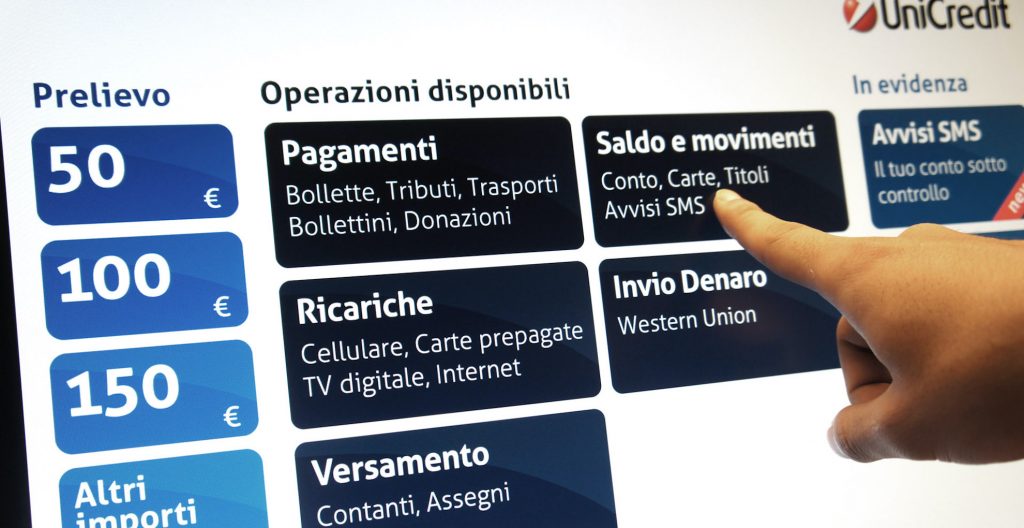
BancoSmart, an award-winning ATM UniCredit Share The human-centered approach is now central to the finance industry, as banks have become savvy in how to best connect to their customers’ needs and desires. As part of this trend, global banking and financial services company UniCredit Bank asked Experientia to create a user-friendly, people-centered ATM – the BancoSmart. 3 things to know Easier and faster The BancoSmart offers more services by using an advanced algorithm that offers users a personalized home page, geo-referenced billing options and tailored services. Improved usability Its UI makes it easier and more intuitive to use, including for people with poor vision; all levels of literacy and non Italian speakers. It is 33% faster in use, has attracted more than 25% of new (non UniCredit) customers, and reduced error rates (non-conclusive interactions) to less than 1%. First mover in Italy First Italian ATM using a touchscreen interface, allowing intelligent and optimized menu interactions. It has been rolled out all across the country. Gallery Video https://player.vimeo.com/video/110351007 In depth Service mix: Design thinking Information architecture Service design Useful links: ADI index showcase Blog post Context ATMs are highly regulated in Italy: to make banking accessible they have to provide a wide range of services, including the payment of various utilities. Many ATM interfaces are not user-friendly and force people to wade through a succession of many screens. They use a language and an organization that reflects the bank, rather than the lived financial experience of the customer. Challenge UniCredit came to Experientia to refresh and redesign the interface. It had to run on various ATM hardwares including legacy terminals of different providers with various screen sizes and tech specifications. We convinced the bank that it could be reinvented, even within the constraints of regulation, hardware and underlying software. Research Experientia carried out in-depth user experience research with ATM users across Italy, spot interviews of current ATM users, stakeholder interviews, card sorting sessions and heuristic evaluation of existing UniCredit and competitor interfaces. This provided foundation for the information architecture and service design of the ATM.We also conducted card sorting activities to create a new navigation structure that fits people’s expectations of where to find features and functions. Design Experientia designed a responsive full touchscreen design solution that works on the various ATM’s. We ran multiple cycles of design, prototyping and usability & user acceptance testing to ensure that the final interface is strongly based on people’s financial behaviors and exceeds their expectations and needs for ATM use. The new menu structure offers much clearer guidance on what functions are found in each menu area, and always offers people the chance to go back to the home page. It has now been rolled out to all UniCredit’s Italian ATM branches. Impact Experientia has reinvented the ATM interface for UniCredit – making it easier to use, faster, and with more services. One of the key innovations is its level of personalization – the ATM has a personalized homepage, with service offers tailored to people’s banking profiles, and a speedy withdrawal function that offers the three most commonly used withdrawal amounts, personalized to each individual user based on their past behavior. Placing these three amounts on the homepage cut the withdrawal time by 30%. Public reactions to the BancoSmart interface have been extremely positive, with clients commenting on the increased speed, legibility, appealing graphics, and the improvement in features and functions. The highly intuitive ATM interaction allows clients to easily navigate, locate and use functions, from simple features like cash withdrawals to more complicated functions like deposits, information retrieval, bill payments and mobile phone top-ups. The interface is visually attractive and easy to read, with large fonts and clear banking function categories. Bancosmart was selected for the ADI Design Index, the annual publication showcasing select Italian Design products considered for the Compasso d’Oro International Award. View our ADI Design Index showcase here. ADI index showcase Blog post Related projects All Services Behavioral design Research and assessment Strategy Finance Banca 5, a new branchless bank model Finance CSA: sentiment-based decision support platform for crypto-currency trading FinanceHealth XME Salute: integrating insurance offerings with wellness and health practices Go back to our portfolio
Customer experience insights to innovation

Customer experience insights to innovation Deutsche Telekom (Germany, Greece, Hungary, Slovakia) Share Experientia has been commissioned by Deutsche Telekom to conduct multiple research activities aimed at envisioning opportunities for new products and services development with diverse time horizons. 3 things to know Improve Deutsche Telekom customer’s home experience Expand upon the range of Deutsche Telekom clients and reshape its existing customer home business. Multi-horizon innovation strategy Identify new business opportunities both for incremental innovation and as opportunities around future needs and trends. Design best practice guideline for CX research Involve internal stakeholders and share project outcomes as a strategic roadmap for innovation research at Deutsche Telekom. Gallery User scenarios User scenarios Insights clustering Workshop day Workshop day In depth Service mix: Design thinking Participatory design Service design Ethnography Useful links: Link External link Context Since home consumer behaviors and needs change over time influenced by various factors such as technological advancements, economic conditions, cultural trends, and individual preferences it is important to keep and a human-centered approach in order to understand if we are addressing the evolving needs and expectations and understanding how to improve existing experiences and design new ones also in the long term. Challenge Identify customer experience strategy that evolves home consumer business opportunities and improves customer experience. Research Experientia has started by conducting stakeholder interviews and hypothesis workshop to define research directions and align with Deutsche Telekom stakeholders. Social media listening activity has coupled with a market and trend research to understand macro phenomenon and identify weak signals, emerging practices and major trends that may have local impact. Expert interviews have been conducted to understand their perspective of the changing customer needs, while in-home customer and lead user interviews helped to understand users behavior and observe emerging behaviors respectively. Design Experientia has analyzed the emerging research information and identified relevant insights. The interview insights have been prioritized using customized analysis-based design tools. Thematic insights have helped to identify moments that matter during customer experience. This information has determined a relevant impact in problem reframing and subsequently in creating initial opportunities, that serves as a basis to shape innovative concepts and value propositions for improving existing experience and shaping new solutions. Impact Experientia created 10 innovative concept value propositions that include added value for current CX, products, service and future products and services experiences. for improving customer experience to successfully defend/reshape business efforts and increase footprint in the homes and minds of Deutsche Telekom customers. Link External link Related projects All Services Behavioral design Research and assessment Strategy Consumer technology Buttonless: engaging users in interactions with keyless devices Brand UXConsumer technology European car aesthetics: Unveiling preferences and values Brand UXConsumer technology Mobile Privacy UX Go back to our portfolio

